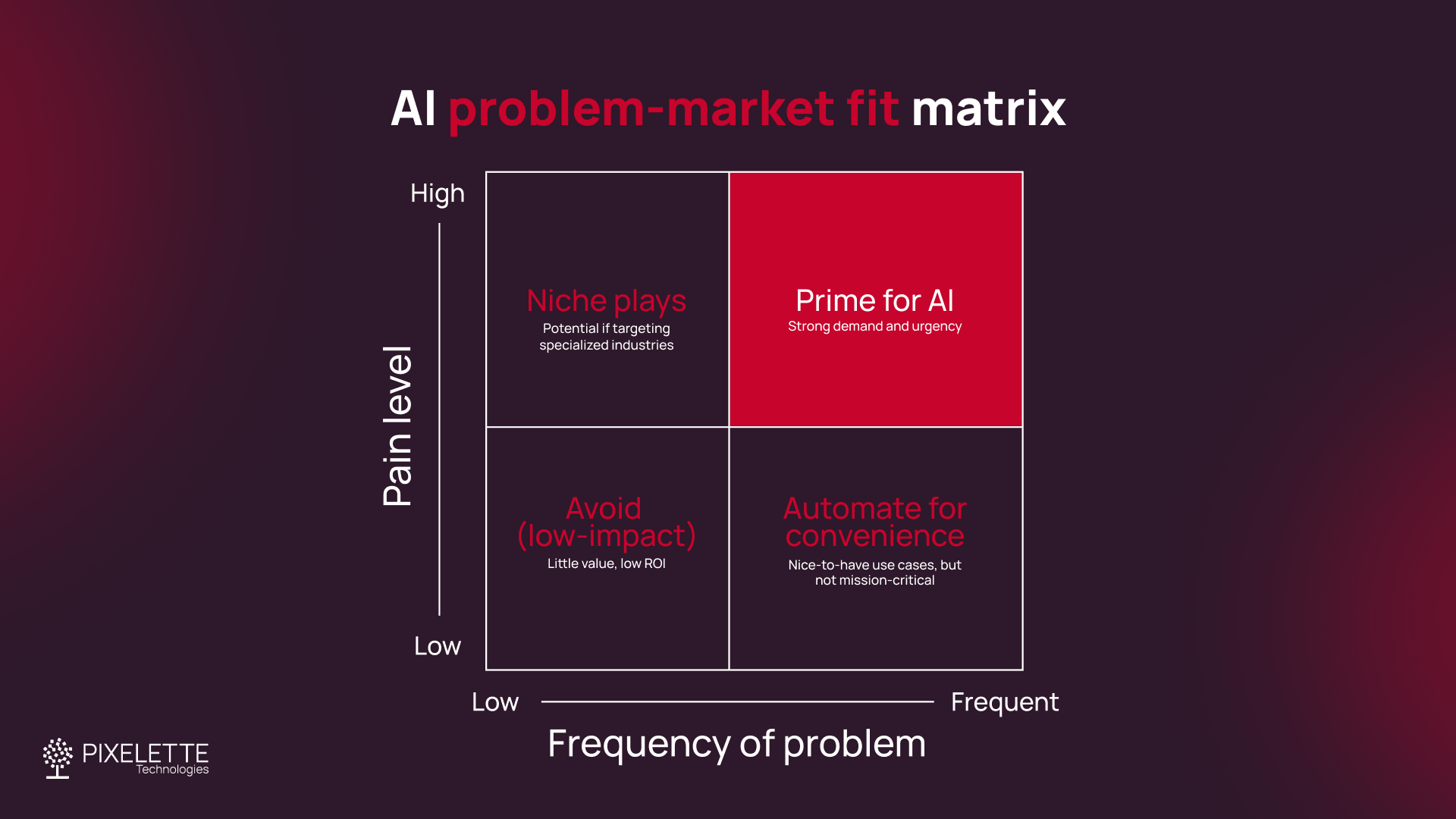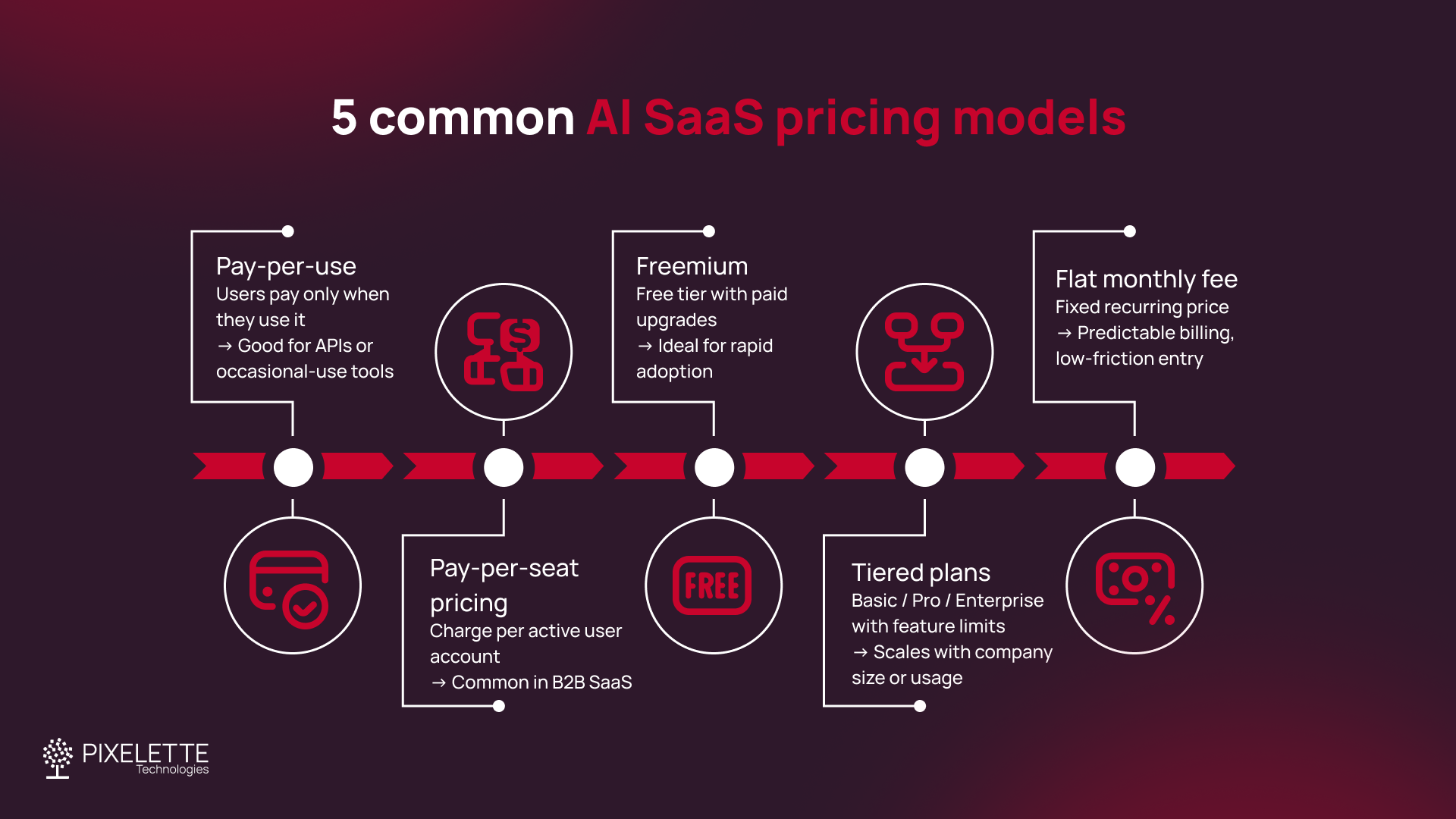How to Start an AI Business in 2025
Written by
Aimun Cheema
Last Updated: June 26, 2025

In this article
- Begin with problem-market fit: Avoid building in a vacuum
- Step 1 → Validate your idea before committing resources
- Step 2 → Select the appropriate AI capability for your solution
- Step 3 → Establish a clear and scalable business model
- Recommended tech stack for AI startups in 2025
- Addressing legal and ethical considerations
- AI business opportunities with high growth potential
- What most founders miss: Operational discipline and iterative learning
- Conclusion
The Future of AI Starts Here
Opt for our AI development services to create intelligent, scalable and efficient solutions. Let’s push the boundaries together. Get Started with a Free Consultation Now.
AI isn’t a distant concept anymore; it’s shaping decisions, products, and policies today. The technology is quietly reshaping how we live, work, and interact, from smart toothbrushes that adjust to your brushing style to tax systems that scan receipts with machine vision. People now treat ChatGPT like their personal search engine, businesses automate 90% of back-office tasks, and regulators are scrambling to keep up.
In this chaotic gold rush, 2025 offers a rare window for first-movers. Big tech hasn’t eaten up every niche yet. If you’ve been sitting on an AI startup idea, now’s your moment. You don’t need to be a Google-level coder or a TED-worthy speaker to launch something valuable!
This guide will walk you through how to start an AI business. Whether you’re a freelancer, solo founder, or domain expert, you’ll learn how to find the right opportunity, validate it, and build it. Simple solutions often require no code at all, but for those that do, don’t worry. There are solution providers around the world ready to help you out.
Begin with problem-market fit: Avoid building in a vacuum
Before getting caught up in models or APIs, stop and ask yourself, who is this really for? Not in theory but in practice.

A lot of people fall into the trap of building clever tools that don’t actually solve anything for anyone. It’s surprisingly easy to build something “cool” that no one ends up using. The startups that are thriving in 2025 are the ones that stay close to the ground, fixing annoying, repetitive problems that real people deal with every day. You’ll see this most clearly in fields like HR, logistics, law, and healthcare.
And the funny thing is, the best ideas don’t usually come from brainstorming. They come from frustration. That one task you hate doing over and over again? The clunky process that wastes your time every week? That’s gold. Those small daily headaches often point to bigger opportunities.
Write down one problem in your daily work that costs you time, accuracy, or mental energy. Be specific. For example, “Manually sorting client emails into categories every morning” is better than “email management.” This pain point will become the foundation of your AI startup idea.
Step 1 → Validate your idea before committing resources
It’s easy to get caught up in building something right away. But before you dive in, take a step back. Ask yourself, does anyone actually want this? That’s what smart founders focus on first. If you’re serious about how to start an AI company, this is the part that matters most.
You don’t need a finished product to find out. Just put together a basic page, something quick, no coding required. Tools like Carrd, Notion, or even Google Forms do the trick. Keep it simple; talk about the problem you’ve noticed, what your idea does to solve it, and ask people to leave their email if they’re interested.
Next, reach out directly to people who would benefit. Post in relevant LinkedIn groups, Slack communities, or subreddits. Ask: “Would this save you time or money?”
Don’t settle for polite feedback. You’re looking for signals of genuine interest: email signups, questions about features, even pushback. And if you want numbers, run a small paid ad (as little as $50) on Facebook or Google targeting your ideal users. Measure clicks, signups, or how long they stay on the page.
If no one bites? That’s not failure. That’s a cheap way of avoiding six months of building something nobody wants.
This step alone separates successful AI startups from passion projects. By validating early, you’re building with confidence, not hope. Remember, viability matters more than novelty.
Step 2 → Select the appropriate AI capability for your solution
Once you’ve confirmed there’s real interest in your idea, the next step is figuring out what type of AI makes the most sense for your solution.
Not every tool needs ChatGPT. The kind of AI you use should depend on what problem you’re solving:
If it’s about writing, summarizing, or responding to language, language-based models (LLMs) are your go-to.
If it involves photos, video, or anything visual, look into computer vision.
If your idea relies on spotting patterns or predicting outcomes, predictive analytics is likely the right direction.
One of the biggest myths about how to start an AI business is thinking you need to train your own models. In reality, 2025 is all about smart integration. Platforms like OpenAI, Claude, or open-source tools already handle the heavy lifting. You just need to plug them in.
If you’re not technical, don’t worry. Tools like Zapier, Bubble, or even custom GPTs let you piece together prototypes without touching code. You can build something functional, fast, and see how people respond.
Instead of chasing cutting-edge algorithms, focus on smart assembly. Use the tech that’s already out there to solve a problem people actually care about. That’s where the real value is.
Step 3 → Establish a clear and scalable business model
An idea is only as strong as the plan behind it. Once you know what your AI tool does and who it helps, the next thing to figure out is how will this make money?
There’s no one-size-fits-all answer here, but most AI startups in 2025 fall into a few patterns:
Productized services → Think of AI tools that do a specific task, like summarizing contracts or drafting emails. These are sold as standalone products.
Vertical SaaS → This means software built for one industry. For example, scheduling tools built specifically for dentists or fitness studios, powered by AI.
Infrastructure tools → These are behind-the-scenes APIs that other developers can plug into their products.
Whatever direction you choose, be honest about your costs, especially around AI usage. Using LLMs and cloud services can get expensive fast. Keep track of things like token usage, compute time, and data storage, especially if you’re offering a free tier.

A simple rule → If your tool saves someone time, money, or headaches, don’t be shy about charging for it. Even early on, you can test pricing by offering a basic paid version and seeing how people respond.
You don’t need a perfect model from day one. But you do need a plan that can grow with you, and some early signals that people are willing to pay.
Recommended tech stack for AI startups in 2025
If you’re worried that building an AI product means you’ll be knee-deep in math papers or model training, don’t be. Most AI startups today succeed by stitching together the right tools, not inventing from scratch.
Here’s a tech stack that’s both modern and manageable:
OpenAI or Anthropic for powering anything language-related
LangChain or LlamaIndex to help your product “remember” past conversations or pull from data sources
Vercel or Supabase for launching your front-end and handling back-end logic
Stripe to manage payments and subscriptions
Posthog or Mixpanel for understanding how people are actually using your product
Each of these tools plays well with the others, so you’re not reinventing the wheel. Even better, many have free tiers, great for early-stage experiments.
The key takeaway here is simple: winning in AI isn’t about building a brand-new engine; it’s about knowing how to assemble a reliable car. Use what’s already out there, focus on solving one clear problem well, and layer in the AI where it counts.
Addressing legal and ethical considerations
Legal and ethical stuff isn’t fun to think about when you’re building your first product, but ignoring it can lead to serious problems later.
You don’t need a fancy lawyer at the start, but you do need to cover the basics. If your product touches user data, make sure you’re not being careless. Countries have rules like GDPR, HIPAA, and others, and they don’t care if you’re a solo founder or a team of 50.
Also, figure out who owns the stuff your AI creates. If a customer uses your tool to write a contract or design something, you’ll want that to be clear upfront.
And be honest about where the AI shows up. People appreciate knowing when they’re talking to a bot vs. a human.
At the very least, have a Privacy Policy and Terms of Service in place. Tools like TrustLayer or Termly make it pretty painless.
If your app deals with high-stakes stuff like health, law, or money, it’s smart to keep a human in the loop. Even a simple review step helps.
Getting this right early on builds trust. It also saves you from messy emails (or worse) down the line.
AI business opportunities with high growth potential
If you're wondering where to start, you’re not alone. The AI space is massive, but the best AI business opportunities often sit in plain sight. The goal isn’t to invent something wild. It’s to find something annoying and fix it.
Here are a few real problems that are wide open in 2025:
Contract summarizers for small law firms. Most of them don’t have in-house AI, but they’re drowning in paperwork. Even simple tools that turn legalese into plain English are a game-changer.
Email writers for real estate agents or recruiters. These folks spend hours crafting repetitive messages. A tool that drafts intros, follow-ups, or status updates? Instant time-saver.
Customer support copilots for small e-commerce brands. Think Shopify stores with tiny teams. A smart sidebar assistant that suggests replies or finds order info? Huge.
AI interview coaches. People prepping for job interviews or sales pitches often practice alone. A tool that gives real-time feedback or helps reframe awkward answers is more useful than you’d think.
Data annotation tools for weirdly specific industries like animal health or environmental surveys. These areas need labeled data, but lack tools built for their niche. If you have inside knowledge here, you’re at a huge advantage.
What do all of these have in common? They’re not flashy. But they solve real, boring problems, and that’s where the money is.
If you can help someone save time, skip a step, or get through their day faster, you’re already halfway to a product that sells.
What most founders miss: Operational discipline and iterative learning
Everyone wants their AI tool to blow up overnight. But here’s the truth: most successful AI businesses don’t go viral, they grow quietly, through consistency.
The founders who win are the ones who listen closely to users, make incremental improvements to their product, and stick with it. They’re not chasing headlines. They’re asking, “What’s confusing about onboarding?” or “Why did that customer churn?”
Share what you’re building. Talk about the ugly parts. Show early results, even if they’re messy. That kind of transparency builds trust and gets better feedback.
Don’t waste time perfecting the logo or reworking your landing page for the 10th time. Talk to your users. Then talk to them again.
If people are paying for your product, even five of them, you’re already running a real business. Everything else is just scale.
Conclusion
Learning how to start an AI business in 2025 isn’t about building flashy tech; it’s about solving a real problem, testing it early, picking the right tools, and growing steadily. You don’t need a PhD or a team of engineers. What you do need is clarity, patience, and the ability to listen.
If you’ve got an idea, the window is wide open right now. Big players haven’t locked down every use case yet.
And if you’re looking for help, that’s exactly what we do at Pixelette Technologies. We work with non-technical founders to build, launch, and scale real, working AI products.
Start now.




